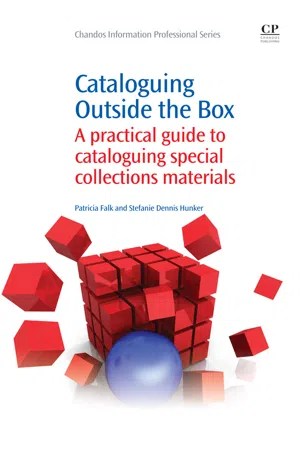
Cataloguing Outside the Box
A Practical Guide to Cataloguing Special Collections Materials
- 260 pages
- English
- ePUB (mobile friendly)
- Available on iOS & Android
Cataloguing Outside the Box
A Practical Guide to Cataloguing Special Collections Materials
About this book
A practical guide to cataloguing and processing the unique special collections formats in the Browne Popular Culture Library (BPCL) and the Music Library and Sound Recordings Archives (MLSRA) at Bowling Green State University (BGSU) (e.g. fanzines, popular sound recordings, comic books, motion picture scripts and press kits, popular fiction). Cataloguing Outside the Box provides guidance to professionals in library and information science facing the same cataloguing challenges. Additionally, name authority work for these collections is addressed.- Provides practical guidelines and solutions for cataloguing challenges- Draws on the authors' varied experiences with these special materials- Addresses specific, unique special collections materials
Frequently asked questions
- Essential is ideal for learners and professionals who enjoy exploring a wide range of subjects. Access the Essential Library with 800,000+ trusted titles and best-sellers across business, personal growth, and the humanities. Includes unlimited reading time and Standard Read Aloud voice.
- Complete: Perfect for advanced learners and researchers needing full, unrestricted access. Unlock 1.4M+ books across hundreds of subjects, including academic and specialized titles. The Complete Plan also includes advanced features like Premium Read Aloud and Research Assistant.
Please note we cannot support devices running on iOS 13 and Android 7 or earlier. Learn more about using the app.
Information
Self-published music scores and recordings
Introduction
Challenges
Cataloguing self-published music scores at BGSU
Table of contents
- Cover image
- Title page
- Table of Contents
- Copyright
- List of tables
- List of examples
- About the authors
- Preface
- Chapter 1: Self-published music scores and recordings
- Chapter 2: Popular music compact discs
- Chapter 3: Fanzines
- Chapter 4: Comics and graphic novels
- Chapter 5: Special periodicals
- Chapter 6: Popular fiction
- Chapter 7: Movie, television, and radio scripts
- Chapter 8: Press kits
- Chapter 9: Authority work
- Chapter 10: Conclusion
- Appendix 1
- Appendix 2
- Appendix 3
- Appendix 4
- Appendix 5
- Appendix 6
- Appendix 7
- Appendix 8
- Appendix 9
- Glossary
- Works cited
- Index